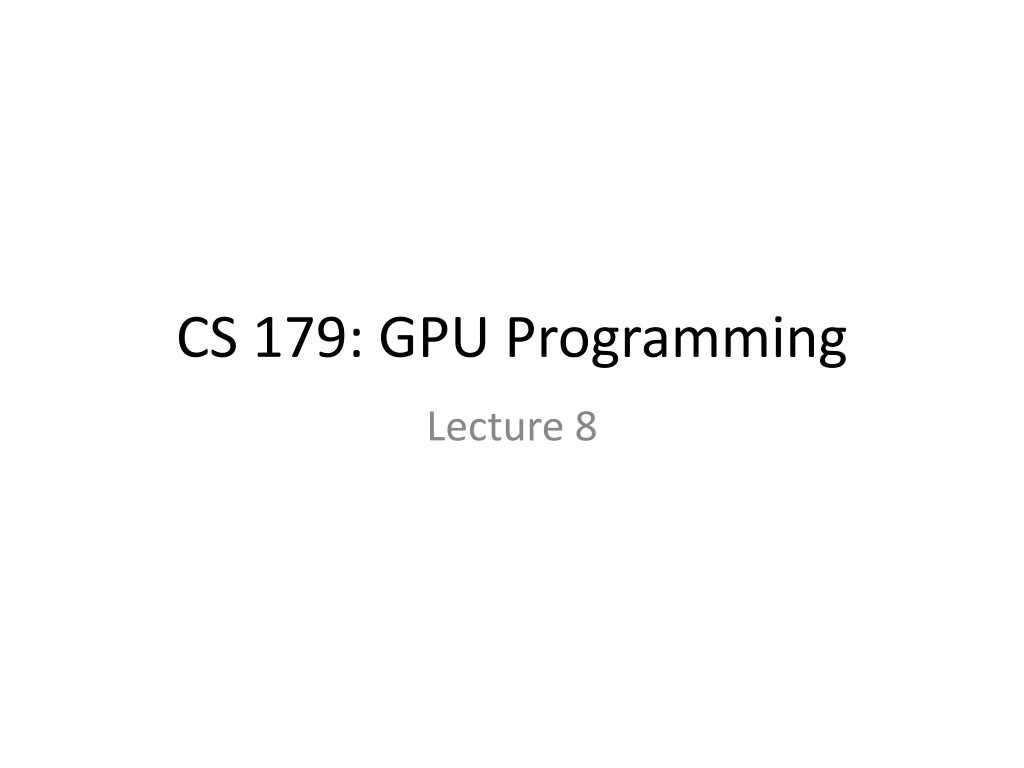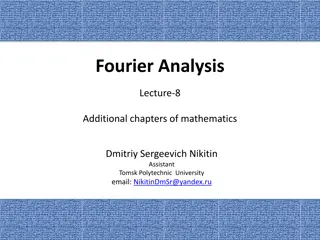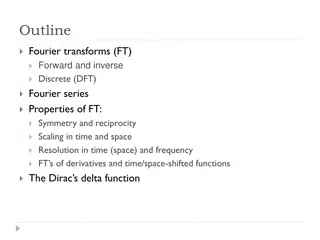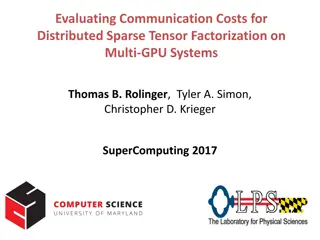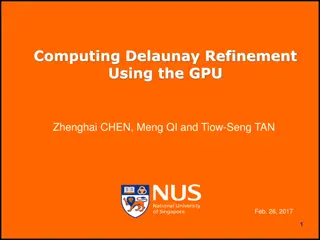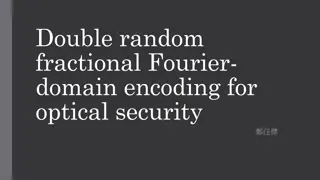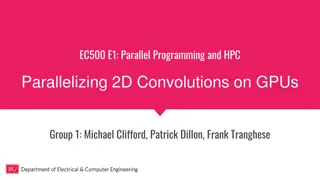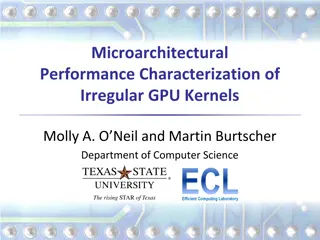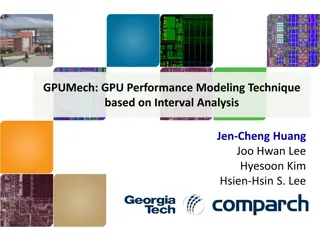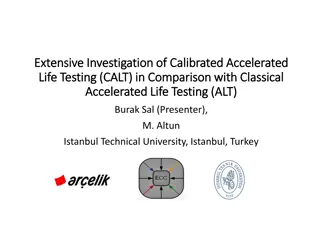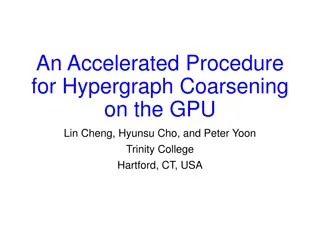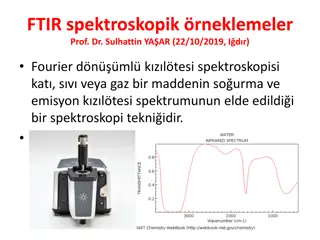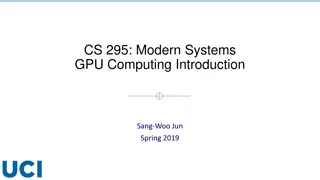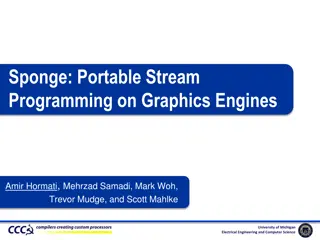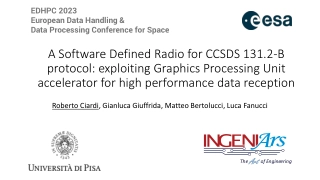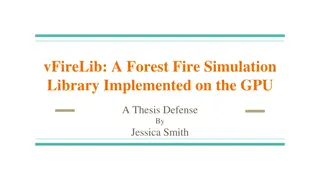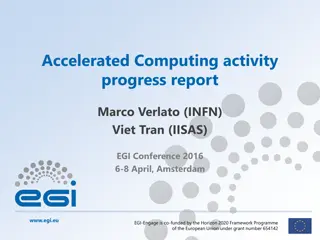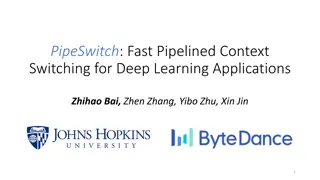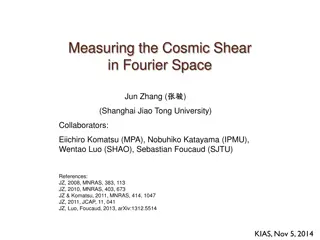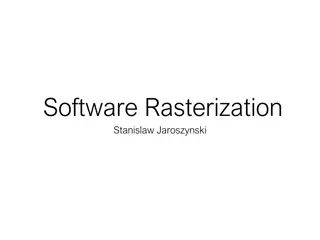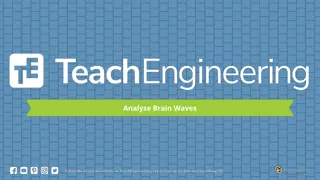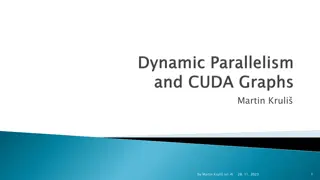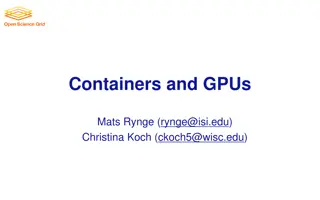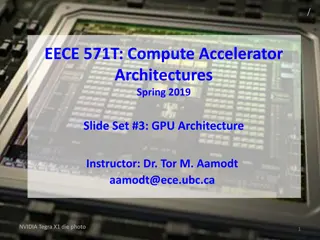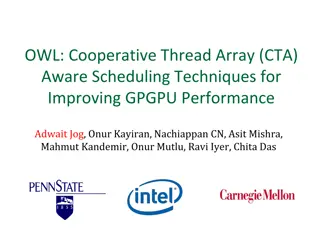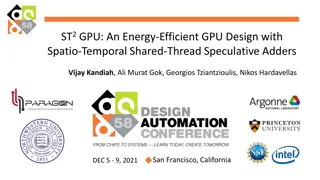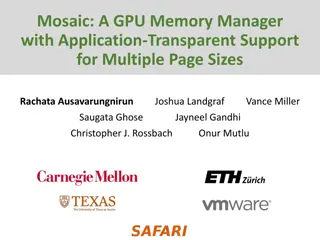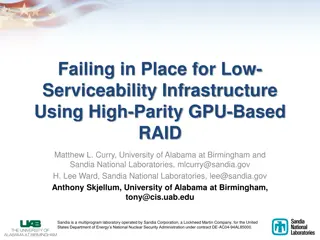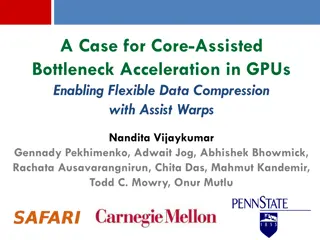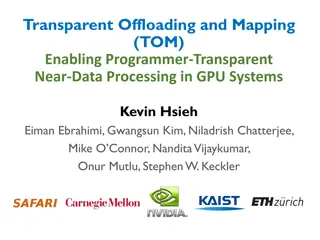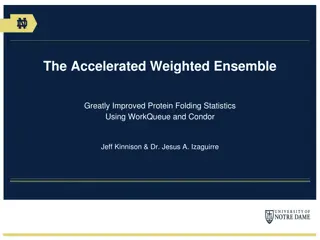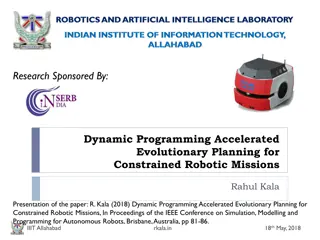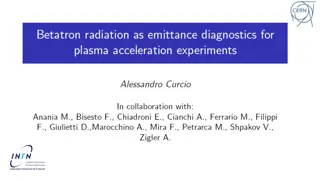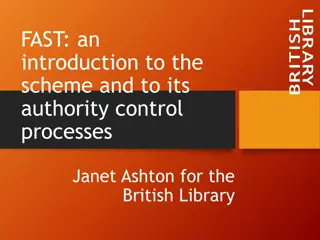Understanding GPU-Accelerated Fast Fourier Transform
Today's lecture delves into the realm of GPU-accelerated Fast Fourier Transform (cuFFT), exploring the frequency content present in signals, Discrete Fourier Transform (DFT) formulations, roots of unity, and an alternative approach for DFT calculation. The lecture showcases the efficiency of GPU-based computations in signal processing applications.
- GPU Acceleration
- Fast Fourier Transform
- Signal Processing
- Discrete Fourier Transform
- Frequency Content
Download Presentation

Please find below an Image/Link to download the presentation.
The content on the website is provided AS IS for your information and personal use only. It may not be sold, licensed, or shared on other websites without obtaining consent from the author. Download presentation by click this link. If you encounter any issues during the download, it is possible that the publisher has removed the file from their server.
E N D
Presentation Transcript
CS 179: GPU Programming Lecture 8
Last time GPU-accelerated: Reduction Prefix sum Stream compaction Sorting (quicksort)
Today GPU-accelerated Fast Fourier Transform cuFFT (FFT library)
Frequency content What frequencies are present in our signals?
Discrete Fourier Transform (DFT) Given signal ? = (?1, ,??) over time, ? = ? ? represents DFT of ? Each row of W is a complex sine wave Each row multiplied with ? - inner product of wave with signal Corresponding entries of ? - content of that sine wave! ? = ? 2??/?
Discrete Fourier Transform (DFT) Alternative formulation: ?? - values corresponding to wave k Periodic calculate for 0 k N - 1
Discrete Fourier Transform (DFT) Alternative formulation: ?? - values corresponding to wave k Periodic calculate for 0 k N - 1 Naive runtime: O(N2) Sum of N iterations, for N values of k
Discrete Fourier Transform (DFT) Alternative formulation: ?? - values corresponding to wave k Periodic calculate for 0 k N - 1 Naive runtime: O(N2) Sum of N iterations, for N values of k
Discrete Fourier Transform (DFT) Alternative formulation: ?? - values corresponding to wave k Periodic calculate for 0 k N - 1 Number of distinct values: N, not N2 !
(Proof) Breakdown (assuming N is power of 2): (Let ??= ? 2??/?, smallest root of unity) ? 1 ?????? ?=0
(Proof) Breakdown (assuming N is power of 2): (Let ??= ? 2??/?, smallest root of unity) ? 1 ?????? ?=0 ?/2 1 ?/2 1 ?(2?)???(2?)+ ?(2?+1)???(2?+1) = ?=0 ?=0
(Proof) Breakdown (assuming N is power of 2): (Let ??= ? 2??/?, smallest root of unity) ? 1 ?????? ?=0 ?/2 1 ?/2 1 ?(2?)???(2?)+ ?(2?+1)???(2?+1) = ?=0 ?=0 ?/2 1 ?/2 1 ?(2?)???(2?)+ ?? ?(2?+1)???(2?) = ?=0 ?=0
(Proof) Breakdown (assuming N is power of 2): (Let ??= ? 2??/?, smallest root of unity) ? 1 ?????? ?=0 ?/2 1 ?/2 1 ?(2?)???(2?)+ ?(2?+1)???(2?+1) = ?=0 ?=0 ?/2 1 ?/2 1 ?(2?)???(2?)+ ?? ?(2?+1)???(2?) = ?=0 ?=0 ?/2 1 ?/2 1 ?(2?)??/2??+ ?? ?(2?+1)??/2?? = ?=0 ?=0
(Proof) Breakdown (assuming N is power of 2): (Let ??= ? 2??/?, smallest root of unity) ? 1 ?????? ?=0 ?/2 1 ?/2 1 ?(2?)???(2?)+ ?(2?+1)???(2?+1) = ?=0 ?=0 ?/2 1 ?/2 1 ?(2?)???(2?)+ ?? ?(2?+1)???(2?) = ?=0 ?=0 ?/2 1 ?/2 1 ?(2?)??/2??+ ?? ?(2?+1)??/2?? = ?=0 ?=0 DFT of xn, odd n! DFT of xn, even n!
(Divide-and-conquer algorithm) Recursive-FFT(Vector x): if x is length 1: return x x_even <- (x0, x2, ..., x_(n-2) ) x_odd <- (x1, x3, ..., x_(n-1) ) y_even <- Recursive-FFT(x_even) y_odd <- Recursive-FFT(x_odd) for k = 0, , (n/2)-1: y[k] y[k + n/2] <- y_even[k] - wk * y_odd[k] <- y_even[k] + wk * y_odd[k] return y
(Divide-and-conquer algorithm) Recursive-FFT(Vector x): if x is length 1: return x x_even <- (x0, x2, ..., x_(n-2) ) x_odd <- (x1, x3, ..., x_(n-1) ) T(n/2) y_even <- Recursive-FFT(x_even) y_odd <- Recursive-FFT(x_odd) T(n/2) O(n) for k = 0, , (n/2)-1: y[k] y[k + n/2] <- y_even[k] - wk * y_odd[k] <- y_even[k] + wk * y_odd[k] return y
Runtime Recurrence relation: T(n) = 2T(n/2) + O(n) Much better than O(n2) O(n log n) runtime! (Minor caveat: N must be power of 2) Usually resolvable
Parallelizable? O(n2) algorithm certainly is! for k = 0, ,N-1: for n = 0, ,N-1: ... Sometimes parallelization outweighs runtime! (N-body problem, )
Recursive index tree x0, x1, x2, x3, x4, x5, x6, x7 x0, x2, x4, x6 x1, x3, x5, x7 x0, x4 x2, x6 x1, x5 x3, x7 x4 x2 x6 x1 x5 x3 x7 x0
Recursive index tree x0, x1, x2, x3, x4, x5, x6, x7 x0, x2, x4, x6 x1, x3, x5, x7 x0, x4 x2, x6 x1, x5 x3, x7 x4 x2 x6 x1 x5 x3 x7 x0 Order?
0 4 2 6 1 5 3 7 000 100 010 110 001 101 011 111
Bit-reversal order 0 4 2 6 1 5 3 7 000 100 010 110 001 101 011 111 reverse of 000 001 010 011 100 101 110 111
Iterative approach x0, x1, x2, x3, x4, x5, x6, x7 Stage 3 x0, x2, x4, x6 x1, x3, x5, x7 Stage 2 x0, x4 x2, x6 x1, x5 x3, x7 Stage 1 x4 x2 x6 x1 x5 x3 x7 x0
(Divide-and-conquer algorithm review) Recursive-FFT(Vector x): if x is length 1: return x x_even <- (x0, x2, ..., x_(n-2) ) x_odd <- (x1, x3, ..., x_(n-1) ) T(n/2) y_even <- Recursive-FFT(x_even) y_odd <- Recursive-FFT(x_odd) T(n/2) O(n) for k = 0, , (n/2)-1: y[k] y[k + n/2] <- y_even[k] - wk * y_odd[k] <- y_even[k] + wk * y_odd[k] return y
Iterative approach x0, x1, x2, x3, x4, x5, x6, x7 Stage 3 x0, x2, x4, x6 x1, x3, x5, x7 Stage 2 x0, x4 x2, x6 x1, x5 x3, x7 Stage 1 x4 x2 x6 x1 x5 x3 x7 x0
Iterative approach Bit-reversed access Stage 1 Stage 2 Stage 3 http://staff.ustc.edu.cn/~csli/graduate/algorithms/book6/chap32.htm
Iterative approach Bit-reversed access Stage 1 Stage 2 Stage 3 Iterative-FFT(Vector x): y <- (bit-reversed order x) N <- y.length for s = 1,2, ,log(N): m <- 2s wn <- e2 j/m for k: 0 k N-1, stride m: for j = 0, ,(m/2)-1: u <- y[k + j] t <- (wn)j * y[k + j + m/2] y[k + j] <- u + t y[k + j + m/2] <- u - t return y http://staff.ustc.edu.cn/~csli/graduate/algo rithms/book6/chap32.htm
CUDA approach Bit-reversed access Stage 1 Stage 2 Stage 3 http://staff.ustc.edu.cn/~csli/graduate/algorithms/book6/chap32.htm
CUDA approach __syncthreads() barriers! Bit-reversed access Stage 1 Stage 2 Stage 3 http://staff.ustc.edu.cn/~csli/graduate/algorithms/book6/chap32.htm
CUDA approach Non-coalesced memory access!! __syncthreads() barriers! Bit-reversed access Stage 1 Stage 2 Stage 3 http://staff.ustc.edu.cn/~csli/graduate/algorithms/book6/chap32.htm
CUDA approach Non-coalesced memory access!! __syncthreads() barriers! Bit-reversed access Stage 1 Stage 2 Stage 3 Load into shared memory http://staff.ustc.edu.cn/~csli/graduate/algorithms/book6/chap32.htm
CUDA approach Non-coalesced memory access!! Bank conflicts!! __syncthreads() barriers! Bit-reversed access Stage 1 Stage 2 Stage 3 Load into shared memory http://staff.ustc.edu.cn/~csli/graduate/algorithms/book6/chap32.htm
Inverse DFT/FFT Similarly parallelizable! (Sign change in complex terms)
cuFFT FFT library included with CUDA Approximately implements previous algorithms (Cooley-Tukey/Bluestein) Also handles higher dimensions
cuFFT 1D example Correction: Remember to use cufftDestroy(plan) when finished with transforms
cuFFT 3D example Correction: Remember to use cufftDestroy(plan) when finished with transforms
Remarks As before, some parallelizable algorithms don t easily fit the mold Hardware matters more! Some resources: Introduction to Algorithms (Cormen, et al), aka CLRS , esp. Sec 30.5 An Efficient Implementation of Double Precision 1-D FFT for GPUs Using CUDA (Liu, et al.)
